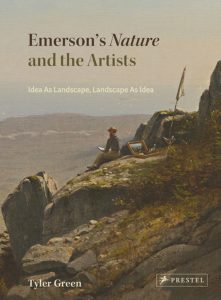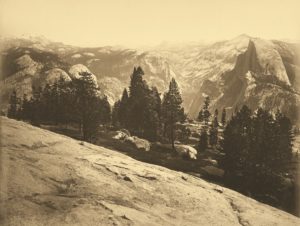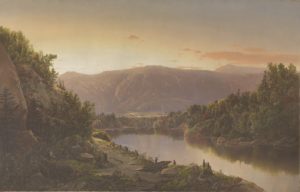Considering the origins of the Cape Cod National Seashore in 1961 doesn’t usually bring Ralph Waldo Emerson, the 19th-century transcendentalist, to mind. Or artists, either. In local imagination, the origin story of the Park belongs in the realm of politics and President John F. Kennedy.
Tyler Green’s Emerson’s Nature and the Artists: Idea as Landscape, Landscape as Idea, published in October, explores how artists and thinkers have influenced our nation and politics, including the cultural construction of the American landscape. Chief among these influences is Emerson. Green describes Emerson’s essay Nature as a starting point.

Before Emerson’s notion of landscape, early Americans regarded wilderness as a dangerous place, with the American project centered on “pitting God’s paradisal garden and civilization against the dangers within Satan’s wild wastelands.” Until Emerson, the term “landscape” was not commonly used. Green highlights a selection from Emerson where the term arises: “The charming landscape which I saw this morning, is indubitably made up of some twenty or thirty farms. Miller owns this field, Locke that, and Manning the woodland beyond. But none of them owns the landscape. There is a property in the horizon which no man has but he whose eye can integrate all the parts, that is, the poet.”
Here the landscape, “an interstitial space between urbanity and wilderness,” is a poetic space where utilitarian private property and frightening wilderness yield to an experience both inspirational and approachable. A place not unlike the National Seashore.
Green quickly points out the dark side of Emerson’s vision. Emerson encouraged American artists to replace their deference to European traditions with direct, immediate engagement with the American landscape. In doing so, he positioned the land as a blank slate, ignoring native people, and, according to Green, displacing and dispossessing them. Consequently, the landscape served as a space for white European domination, however poetic or picturesque that domination may have appeared through the eyes of poets and artists. Throughout the text, Green continually aligns art and politics, showing their interdependence in establishing an idea of America in the 19th century — a construction whose implications we still grapple with today. The recent decision to waive beach fees for Native Americans reverberates with some of these very issues.
Emerson’s Nature invites multiple interpretations. Green’s reading prioritizes two perspectives: one postcolonial and the other art historical. Frustrated by the fact that more people quote Emerson than read Emerson, however, Green includes the entirety of Nature in his book, allowing the reader to approach it on his or her own terms.

Green inserts a selection of 19th-century landscape paintings and photographs in three of his own essays and Emerson’s text. The book has a hybrid form, with the reader constantly shifting between Green’s academic voice and Emerson’s warm, mystical tone. Additionally, the images must be read, not viewed as illustrations. Green writes lengthy captions for each image, but the pictures themselves convey their own knowledge, an experience similar to viewing an exhibition.
The art reveals the mutual influence of artists on Emerson and Emerson’s influence on multiple generations of artists. Green first became interested in writing about Emerson through his study of Carleton Watkins, a San Francisco-based photographer active in the late 19th century. Two of his images hung in Emerson’s sitting room. In the context of his book, Green includes a photograph Watkins took in Yosemite Valley. The black-and-white image of a mountain and its reflection in a perfectly still lake illustrates shared Emersonian themes, namely the use of a reflection as a conceptual device for understanding nature as something both “common” or elemental and also “philosophical” in import.
“All natural objects make a kindred impression, when the mind is open to their influence,” Emerson wrote. Green interprets Watkins’s reflection as a metaphor of the Union, the artist answering Emerson’s call to “wield nature as metaphor.”
Spiritualized paintings of mountains, sunsets, and sunrises proliferate throughout the book. It’s a visual feast. The works embody Emerson’s argument for nature to serve as a place of divine encounter. In William Louis Sonntag’s painting On the Potomac, the artist depicts the sun beginning to rise over a mountain range, the murky, pastel light reflected in the river. Green traces the image’s Americanness to Emerson and interprets the sunrise as a “potent metaphor for America’s emergence and promise.”

The sheer quantity of visual images builds the case for Emerson’s influence stretching into the 20th century. At the end of the book, Green devotes an essay to the eventual rejection of Emerson by artists including Charles Sheeler. Subverting Emerson’s reflection metaphor, his painting American Landscape depicts a factory reflected in the River Rouge, asserting “how mega-capital now dominated America and its land.” Yet Green points out that Sheeler and other precisionists couldn’t outrun the Emersonian influence completely: they were still making art about America.
On Cape Cod, the landscape is so ingrained in our understanding of the place that it’s hard to see it from a distance — a distance marked by either criticality or renewed awe. Green’s book reveals a central tension between his scholarly view of the landscape as a constructed space and Emerson’s spiritual vision of it as “the great organ through which the universal spirit speaks to the individual.” Regardless of where the reader positions oneself on this continuum, this book is a call to open our eyes and see the landscape anew.
One may see a racist colonial past reflected in the landscape. Another may “see the miraculous in the common.” If we try hard enough, we might just rebuff Emerson’s claim that “few adult persons can see nature.”
